Fig. 3.1
Diagrammatic representation of the apical anatomy in a tooth (a) without apical root resorption and (b) a tooth with apical root resorption. Note (1) radiographic apex (dash line) as judged on a radiograph, (2) major diameter or apical foramen (AF) (solid line), (3) minor diameter or apical constriction (AC) (green dash line), (4) dentine, and (5) cementum. The red dotted line is the CDJ
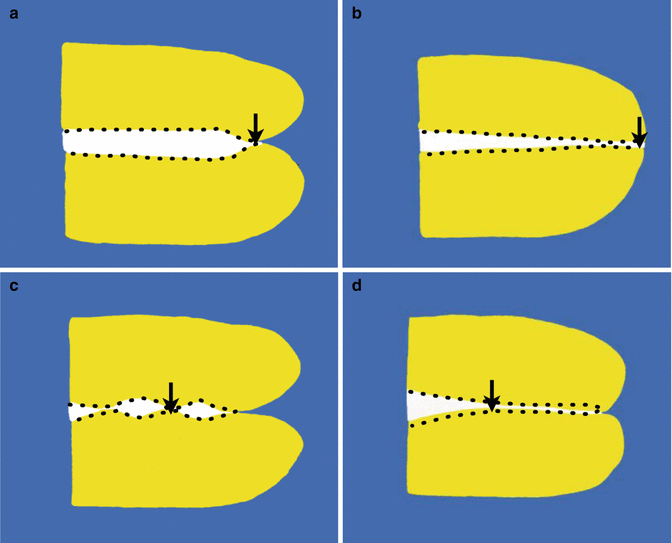
Fig. 3.2
Diagrammatic representation of classification of apical constriction. Arrow indicated narrowest portion of canal and point of measurement. Note (a) type A traditional single constriction, (b) type B tapering constriction, (c) type C multi-constriction, and (d) type D parallel constriction (Adapted from Dummer et al. [42])
Traditional methods for determining WL have been the use of tactile sensation [43], the observation of bleeding points or moisture using a paper point technique [44, 45] and radiographic length determination [46].
The paper point technique used conventional absorbent paper points to determine WL. The technique is used as a method to determine final working length prior to obturation. It can only be used after initial shaping of the canal has been completed and where the patent canal is dry. WL is determined by the tip of the paper point and by the presence of either blood or tissue fluid indicating insertion beyond the foramen. Repeated points are used to determine the wet/dry points within the canal before final refinement of canal preparation [44, 45].
The radiographic apex is defined as the anatomical end of the root as seen on the radiograph [37]. Since this is visible radiographically, it has been widely used as a reference for determination of WL. Commonly 0.5–1 mm short of the radiographic apex has been used as a guide for determining termination of root canal preparation, and this is only an estimate. The radiographic apex and the anatomical canal terminus (where the canal exits the root) do not coincide. Frequently, canals exit short of the radiographic apex, and curvatures in the bucco-palatal/lingual plane will not be assessed using a two-dimensional image. Conversely when a file can be seen beyond the radiographic apex (such as the use of patency filing), we can be sure, without doubt, that we are beyond the confines of the canal. Radiographic determination of WL is subject to magnification, distortion, inter- and intra-observer variability and lack of three-dimensional representation. Despite inaccuracies, the use of radiographic length determination in combination with other techniques will give you the most accurate information as to the correct WL [53].
None of the aforementioned traditional techniques can truly satisfactorily determine the WL. The CDJ is a practical and anatomic termination point for the preparation and obturation of the root canal, and this cannot be determined radiographically. Modern electronic apex locators can determine this position with accuracies of greater than 90 % with some limitations. Knowledge of apical anatomy and the use of radiographs in combination with the correct use of an apex locator will assist practitioners to achieve predictable results [47]. The first electronic device for root canal length determination was constructed by Sunada using direct current based on the principle that the electrical resistance of the mucous membrane and periodontium registered 6.0kΩ in any part of the periodontium [48].
A number of electronic apex locator devices have been developed measuring resistance or impedance using frequencies (high, two or multiple) or low-frequency oscillation and/or a voltage gradient method to detect the canal terminus when an endodontic file penetrates inside the canal and approaches the apical constriction (minor apical foramen) [49]. Third-generation apex locators such as the Root ZX (J. Morita, Tokyo, Japan) were developed to calculate the ratio of two electrical impedances in the same canal using two different current frequencies to determine the canal length precisely even in the presence of electrolytes (root canal irrigants, serous intra-canal fluids, purulent exudate, haemorrhagic exudate) or vital pulp tissue in the root canal [50]. The Root ZX has been shown to be 90 % accurate to within 0.5 mm of the apical foramen and 100 % if accurate if 1.0 mm is accepted [51, 52]. Based on the majority of studies carried out in the endodontic literature, 0.5 mm should be subtracted from the length of the file at the point when the device suggests the file tip is in contact with the PDL (zero reading). This measurement does not indicate that the apical constriction has been located but rather that the instrument is within the canal and is close to the periodontal ligament [49]. Even though apex locators appear to be excellent tools for the determination of WL, they should be used as an adjunct and not as a substitute for radiographs. In fact, the combined use of electronic apex locators and radiographs of the initial or master apical file has been shown to be more accurate than the use of radiographs alone [53].
Apical patency is a technique in which the apical portion of the canal is maintained free of debris by recapitulation with a small file through the apical foramen [54]. Proponents of maintaining patency throughout the cleaning and shaping procedures are based on the belief that this helps to control debris accumulation in the apical portion of the canal preventing ledge formation, transportation and apical perforation [55]. In the teeth with necrotic and infected pulps, the use of patency filing ensures that mechanical and biological goals of cleaning and shaping are achieved by ensuring that cleaning and shaping procedures are carried out to the full extent of the canal (Fig. 3.3). In vital cases, apical patency is intended to prevent compaction of dentine chips into the apical region forming a plug that can interfere with WL [56]. The use of this technique is a matter of controversy, and antagonists claim this type of filing beyond the confines of the canal is biologically unacceptable with risks of over-enlargement of the apical foramen [57], damage to the periapical tissues [40] and inadvertent extrusion of contaminated dentine chips or bacteria leading to postoperative pain and sequelae [58].


Fig. 3.3
Clinical radiographs demonstrating (a) preoperative view and (b) postoperative view of tooth 36. Note the use of apical patency filing ensures that complex apical anatomy has been satisfactorily treated
Both stainless steel and nickel-titanium rotary instruments carry the risk of instrument fracture either as a result of flexural (fatigue fracture) or torsional (shear failure) stresses. Canal curvatures are thought to be the predominant risk factor for instrument failure through flexural stresses. To reduce the risk of file fracture when using rotary instrumentation techniques, coronal preflaring and the use of a manual or rotary glide path can help reduce stresses on the instrument [59]. The new PathFile NiTi rotary instruments (Dentsply Maillefer, Ballaigues, Switzerland) for mechanical preflaring have been recently introduced on the market and have demonstrated significantly less modification of canal curvature and fewer canal aberrations when compared to manual preflaring with stainless steel instruments [60].
The ideal final size of apical canal preparation remains controversial. The apical portion of the root canal system can harbour microorganisms that account for periapical pathosis and persistent inflammation; therefore, treatment interventions that allow for maximum reduction of pathogens should be indicated in the treatment of infected root canal systems [41]. Traditionally, final apical preparation techniques advocating enlarging the apical part of the root canal to three-four sizes larger than where the first file bound have been recommended [61]. However, this concept has been questioned as a result of recent studies, which indicate up to 60 % of untouched canal walls that could contain biofilm [28]. Furthermore, Wu and colleagues demonstrated that in 75 % of root canals, the first instrument to bind at the apex had contact on the canal wall on one side only, and in 25 % the instrument tip had no contact with the canal wall at all [62]. A second school of thought from North America aimed to keep the apical diameter and preparation as small as practically possible. This concept of root canal preparation included establishing and maintaining patency using a small #10 K file 1 mm through the foramen and finishing the apical one-third to at least a size #20 [1]. Corresponding to this technique, modern rotary instruments such as ProTaper Universal finishing instruments have apical diameters ranging from 0.20 to 0.30 mm.
Classical bacteriological studies indicated that mechanical instrumentation alone resulted in significant reduction of bacteria but could not predictably achieve bacteria-free root canals [63]. Even combining mechanical preparation, antibacterial irrigants and intra-canal antimicrobial dressings did not achieve bacteria-free root canals, demonstrating the limited antibacterial effect of chemomechanical preparations [64, 65]. Ørstavik and colleagues studied the effects of chemomechanical root canal preparation in 23 teeth with apical periodontitis. Following a step-back technique and irrigation with sterile saline, 14 teeth yielded positive cultures at the end of the first appointment. Following a 7-day dressing of calcium hydroxide, this number was reduced to eight teeth [66]. Dalton and colleagues studied the effects of both stainless steel and nickel-titanium instruments in a clinical study of 48 teeth with apical periodontitis. In terms of bacterial reduction, no difference could be found with either technique although increasing instrument size reported increased bacterial reduction. Nevertheless, it was not possible to achieve bacteria-free root canals [67].
Rollinson and colleagues compared the removal of radioactively labelled bacteria using two different rotary NiTi preparation techniques. Preparations to size #50 (using Pow-R instruments) resulted in reduced bacterial counts compared to size #35 (using GT rotary and profile) (see Figs. 3.4 and 3.5) [68]. A recent systematic review suggested that contemporary chemomechanical debridement techniques with canal enlargement techniques do not eliminate bacteria during root canal preparation at any size [69]. The same authors carried out a similar systematic review assessing healing outcomes related to small and large master apical file sizes. They concluded that with the limited information available, the best current available clinical evidence suggests that for patients with necrotic pulps and periapical lesions, enlargement of the apical size would result in an increased healing outcome in terms of clinical and radiographic evaluation [69, 70].
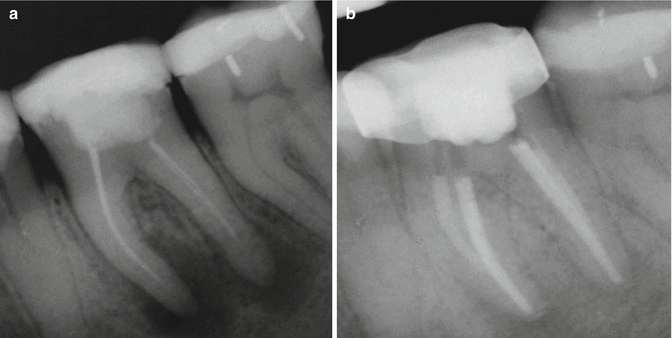
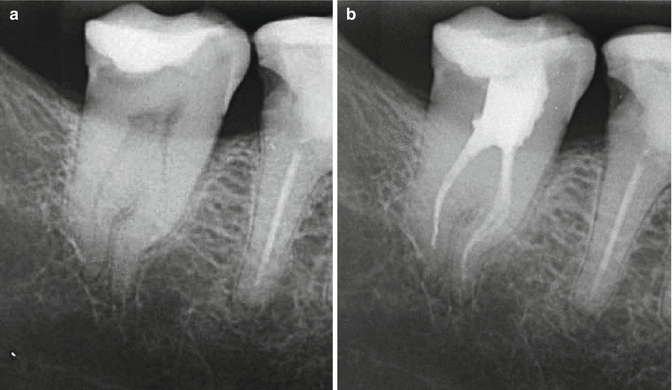

Fig. 3.4
Clinical radiographs demonstrating nonsurgical endodontic re-treatment of tooth 36. Note (a) preoperative film demonstrating incomplete suboptimal obturation that reflects inadequate cleaning and shaping procedures. Note extensive periradicular pathology associated with both apices. (b) 6 months posttreatment radiograph demonstrating complete healing of the case. Apical preparation sizes were #50 in mesial and distal canals

Fig. 3.5
Clinical radiographs of an S-shaped curvature in tooth 47. Note (a) preoperative radiograph and (b) postoperative radiograph following chemomechanical preparation procedures and final obturation. Apical preparation size mesially was to a size #20 to prevent iatrogenic canal transportation which could lead to failure
Irrigation type, volume and depth of penetration are all crucial factors related to effectiveness and hence microbial reduction. Irrigants commonly delivered by syringe and needle devices indicate that successful irrigation delivery is related to canal diameter and curvature, and contemporary needle gauges used (27 and 30 gauges) require 0.42 and 0.31 mm diameter preparations, respectively. Therefore, the minimum canal size preparation when using a 30-gauge needle is 0.31 mm for the needle and therefore irrigant to reach within 1 mm of the WL (for more detailed discussion, see Chap. 5).
The uses of antimicrobial inter-appointment intra-canal dressings such as calcium hydroxide are also regarded as important adjuncts to optimize cleanliness and disinfection within the root canal system. Cleaning and shaping procedures facilitate placement of a suitable dressing that can further reduce microbial flora by virtue of its antimicrobial effects combined with its ability to suppress the nutritional supply that may allow further growth and multiplication of any remaining organisms (see Chap. 6 for more detailed discussion).
In summary, the goal of effective cleaning and shaping procedures is to remove all necrotic and vital organic tissue as well as some infected hard tissue from the root canal system. Correct shaping procedures with maintenance of original anatomy (with reference to the apical constriction) without iatrogenic deviation (canal transportation) facilitate optimal and effective irrigant deposition and predictable placement of intra-canal medicament and facilitate permanent root fillings without risk of overfilling. Mechanical preparation techniques in terms of correct WL and master apical file size must be carried out with antimicrobial chemical treatments in mind (Fig. 3.6).
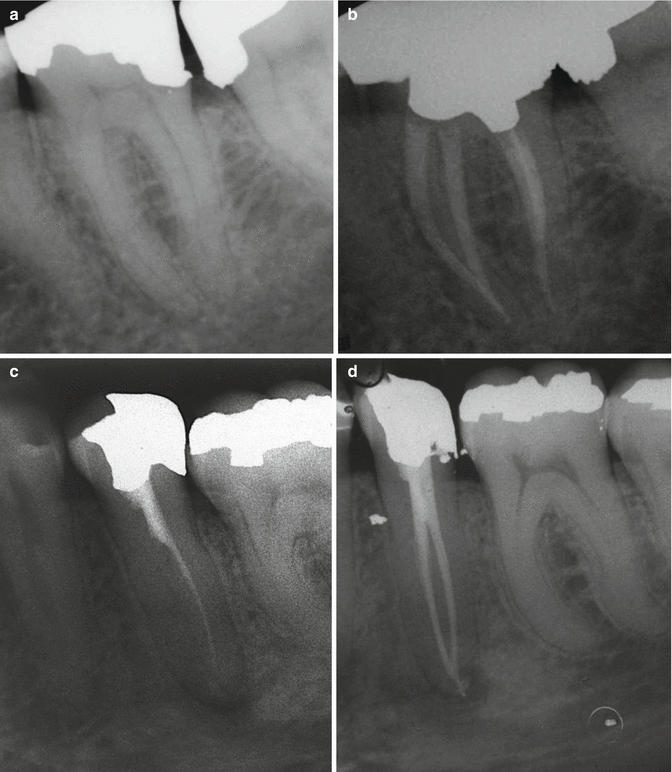

Fig. 3.6
Clinical radiographs demonstrating (a) pre- and (b) postoperative radiographs of primary root canal treatment carried out with nickel-titanium rotary files and (c) pre- and (d) postoperative radiographs of root canal re-treatment using stainless steel files. Cleaning and shaping procedures were carried out successfully irrespective of file design used. Key concepts utilized in both cases to ensure overall success include apical patency filing, recapitulation, working length determination (using radiographic and electronic methods), use of chemical disinfectants, and intracanal medicaments. Obturation procedures not only serve to prevent bacterial recontamination but also reflect the overall cleaning and shaping procedures carried out
3.2 Radiographic Working Length Determination
The radiographic technique for determining WL is probably the most widely used technique to determine the end point of cleaning and shaping to facilitate final obturation. Clinicians should be aware of the limitations when carrying out such procedures and methods to ensure accuracy for interpretation. It is essential to have a preoperative diagnostic film (conventional or digital) using a paralleling cone beam-aiming device to ensure minimum distortion.
The use of digital radiography allows for easy and quick determination of the WL film with a file in position. The radiation dose is reduced when compared to conventional plain film radiography. Imaging software programs used with these devices allow for image modification including colour, contrast and magnification, which can be very helpful when assessing the apical limit of preparation. One must bear in mind with any conventional radiographic technique that the image is only a two-dimensional representation of a three-dimensional object, and so curvatures typically present in the buccal to palatal/lingual direction will remain undetected. Superimposition of anatomical structures such as the zygoma or zygomatic arch in the maxillary molar region or screws/plates/orthograde or retrograde fillings or overfills can also make WL interpretation difficult when using radiographs (Fig. 3.7 ).
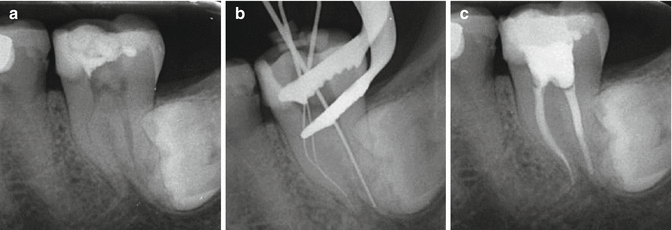

Fig. 3.7
Clinical radiographs demonstrating superimposition of a horizontally impacted wisdom tooth that makes radiograph determination of the working length difficult. Note (a) preoperative view demonstrating difficulty assessing distal root of tooth 37. (b) Working length files confirmed using an electronic apex device to determine master apical file and end point of preparation procedure. (c) Final obturation carried out with confidence without any risk of iatrogenic overfilling that could result in potential inferior dental nerve damage
Radiographic determination of WL should therefore always be complimented with the use of an electronic apex locator to determine the correct WL based on the results of both techniques. Occasionally, the electronic apex locator method may not be possible requiring the sole use of a radiographic technique to estimate correct length. A typical example may be when you are working through a metallic restoration or metal crown, which results in short-circuiting and inaccurate readings.
To determine accurate WL’s radiographically, the following guidelines are recommended:
- 1.
All files should be placed in each canal that have been identified to correct estimated working length corresponding to reference points on the tooth (in multi-rooted teeth, this is preferable to taking multiple X-rays with separate files ensuring minimum radiation exposure).
- 2.
Correct working length in each canal should be confirmed with the use of an electronic apex locator (see later) to verify 0.5 mm from 0 reading.
- 3.
When using conventional film radiography, fresh developer and fixer must be available and developing carried out according to recommendations (time and temperature dependant).
- 4.
The clinician must set the correct exposure for the film according to anatomical site and size of patient to ensure the resultant film is not under- or over-exposed resulting in poor image interpretation.
- 5.
A parallel beam-aiming device should be used. This allows for minimal distortion of the WL film and comparable films that are useful during the later stages of treatment (an example is when further adjustments are required during the obturation phase).
- 6.
Working length films should be reviewed, and if the distance between the file tip and root apex is greater than 1 mm, then another film is recommended with adjustments made accordingly.
- 7.
When the file is seen beyond the radiographic apex, there is no doubt that the file is beyond the canal terminus.
- 8.
When treating teeth with buccal and lingual canals, the use of the buccal object rule (SLOB same lingual opposite buccal) is essential when making distinctions between the canals, which may require length adjustment. Remember as the X-ray tube moves from posterior (distal) to anterior (mesial) objects imaged on the film that are on the lingual aspect (disto-lingual, mesio-lingual and palatal roots) will be positioned mesially.
3.3 Electronic Working Length Determination
The cement-dentinal junction is the point at which the pulp tissue changes into the apical periodontal tissue and is the most ideal physiological apical limit of preparation. This point is also referred to as the apical constriction. The apical constriction does not coincide with the anatomic apex and is often deviated such that in a bucco-lingual plane, it will be impossible to confirm radiographically the exact position the file exits the tooth. The electronic apex locator, functioning on direct current, has proven to be a reliable method for determining the point at which the file exits the canal meeting the periodontal tissues. Furthermore, superimposition of certain anatomic structures (impacted teeth, tori, zygomatic arch, excessive bone density and overlapping roots) makes radiographic confirmation of working length difficult at times. Electronic apex locators are a reliable method of determining working lengths in addition to conventional radiography. Frequently, treatment time and radiation dose exposure to the patient can be routinely reduced when compared to working length determination using conventional radiography alone.
The Root ZX based on the “ratio method” for measuring the root canal length measures the impedances of 0.4 and 8 kHz at the same time, calculating the quotient of the impedances and expressing this quotient in terms of the position of the file within the canal. A built-in microprocessor automatically controls the calculated quotient to have a relationship between the position of the file within the canal and the digital read-out when the file is placed in the coronal portion of the tooth. When the file is in the canal, the apex locator cannot tell you accurately what distance it is from the canal terminus even though most apex locators display a numeric value as the file progresses towards the apex (see Fig. 3.8 ). However, when the file reaches the canal terminus, the screen will display “0”, and the clinician can accurately determine that the tip of the instrument is at the apical constriction (Fig. 3.9 ).

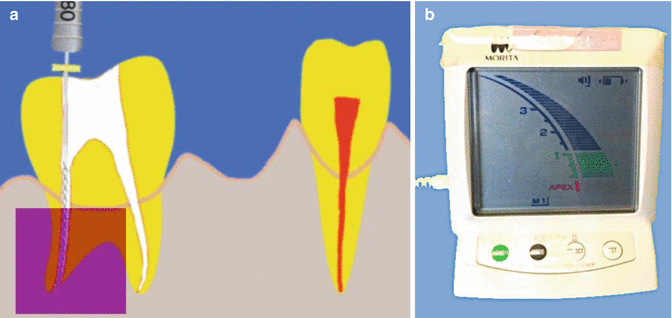

Fig. 3.8
(a) Diagrammatic representation and (b) clinical photograph of Root ZXII apex locator demonstrating digital reading when the file is placed in the canal. The graphic representation of the arbitrary units ‘3-2-1’ displayed on the apex locator does not give you any reliable distance from the apex. The clinical technique of working length determination is to advance the file until the unit reads ‘APEX’. At this point an audible alarm changes from a beep to a full tone

Fig. 3.9
(a) Diagrammatic representation and (b) clinical photograph of Root ZXII apex locator showing the digital reading when the file is at the apical constriction. If the file is advanced further then the unit reads ‘APEX’ with an audible alarm. The working length is then determined by subtracting 1 mm from the length measured when the meter flashes the first bar at the “Apex” and the sound first changes from a beep to a full tone. A radiographic image should be exposed with a small diameter files in the tooth at the electronically determined working length for verification
This feature is not only helpful for accurately determining the point at which pulpal and periodontal tissues (PDL) meet but also a reliable method when radiographic information at the apex is limited due to superimposition of other surrounding structures. The clinician should subtract 0.5 mm from the length of the file at the point when the device suggests the file tip is in contact with the PDL (zero reading). This measurement does not indicate that the apical constriction has been located but rather that the instrument is within the canal and is close to the periodontal ligament.
Although reliable, accurate and simple to use, some precautions and points of interest that are noteworthy when using the devices include the following:
- 1.
A preoperative diagnostic parallel radiograph is essential for determining an estimate of working length prior to file insertion.
- 2.
The lip hook should be placed under the rubber dam.
- 3.
Metallic parts from the crown of the tooth including amalgam or crown should not come into contact with the file when using an apex locator. If contact occurs, the current is shunted resulting in an unstable electrical signal with rapid wandering signs.
- 4.
The access cavity and pulp coronal pulp chamber should be relatively fluid-free although some fluid should be retained within the canals themselves.
- 5.
The second electrode clip is attached to the file, and the file is placed within the canal and slowly advanced apically using a watch-winding movement (see later). The file is advanced until a stable “O” reading is achieved. The most stable reading is readily achieved when the file size approaches the natural apical constriction size. The file must fit snugly within the canal and have good electrical contact with the canal walls. Erratic readings suggest the file used is too small and the clinician is advised to change to a larger file size until the reading stabilizes.
- 6.
The measurement should be checked and confirmed at the “O” reading. The file should be advanced slightly beyond the “O” reading and then slowly pulled back into the apical constriction to find the exact point at which pulp and periodontal tissue meet (Fig. 3.10). The rubber stopper should be placed at a reliable reference point on the tooth prior to file removal. The working length is calculated as 0.5 mm from the “O” reading length. Once all the canals have been measured, a working length radiograph is taken to confirm lengths.
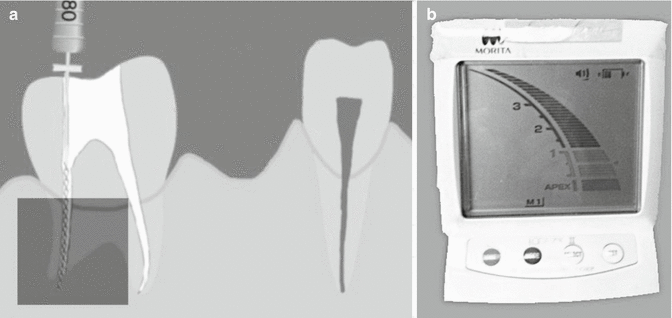 Fig. 3.10(a) Diagrammatic representation and (b) clinical photograph of Root ZXII apex locator showing the digital reading when the file is passed beyond the apical constriction. At this point, we are certain that the file meets the periodontal apical tissues and we have confirmed canal patency. The file should be slowly pulled back confirming the exact point where an audible alarm for ‘APEX’ is reached. Care should be taken to advance small k files to ensure that apical foramen enlargement does not inadvertently occur when confirming working length. A reliable stable reading should be reproduced using the smallest file size possible
Fig. 3.10(a) Diagrammatic representation and (b) clinical photograph of Root ZXII apex locator showing the digital reading when the file is passed beyond the apical constriction. At this point, we are certain that the file meets the periodontal apical tissues and we have confirmed canal patency. The file should be slowly pulled back confirming the exact point where an audible alarm for ‘APEX’ is reached. Care should be taken to advance small k files to ensure that apical foramen enlargement does not inadvertently occur when confirming working length. A reliable stable reading should be reproduced using the smallest file size possible - 7.
The measurement should be checked and confirmed at the “O” reading. The file should be advanced slightly beyond the “O” reading and then slowly pulled back into the apical constriction to find the exact point at which pulp and periodontal tissue meet. The rubber stopper should be placed at a reliable reference point on the tooth prior to file removal. The working length is calculated as 0.5 mm from the “O” reading length. Once all the canals have been measured, a working length radiograph is taken to confirm lengths.
- 8.
In the case of preparing curved canals, it is recommended to recheck the working lengths following apical canal preparation since inherent straightening of the canal will result in working length changes of up to 1 mm.
- 9.
Premature readings when the file has not advanced to the estimated working length calculated from preoperative diagnostic radiographs may indicate perforations within the root canal or can be associated with a wide-open apex. Occasionally, excessive fluid, exudate, pus or bleeding may interfere with the readings requiring removal using absorbent paper points. Conventional plain film or digital radiography may help confirm whether the file is indeed within the root canal or has exited prematurely suggesting perforation (see Fig. 3.11).
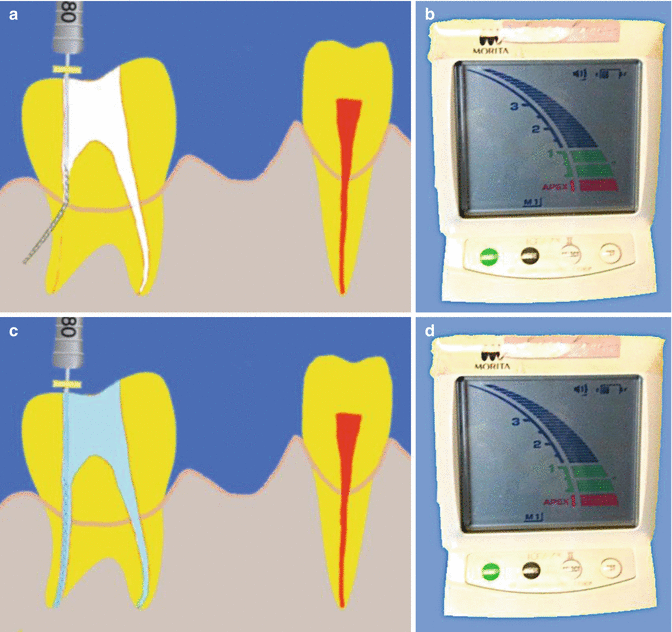 Fig. 3.11Clinical diagram and photographs demonstrating (a) and (b) placement of a file into a perforation. Strip perforations can be detected and their position measured when ‘APEX’ is reached well short of the working length. Furcation perforations can also be detected if ‘APEX’ is registered when a file is inserted into a would-be-canal. Apical perforations may also be detected indicated by a sudden change in working length previously verified by the apex locator. Note (c) and (d) inaccurate readings on the apex locator as a result of excessive fluid (blood, irrigants, pus) within the canal or coronal pulp chamber. If the advancing file comes into contact with metallic restorations in the coronal pulp chamber instant and erroneous ‘APEX’ readings can also occur
Fig. 3.11Clinical diagram and photographs demonstrating (a) and (b) placement of a file into a perforation. Strip perforations can be detected and their position measured when ‘APEX’ is reached well short of the working length. Furcation perforations can also be detected if ‘APEX’ is registered when a file is inserted into a would-be-canal. Apical perforations may also be detected indicated by a sudden change in working length previously verified by the apex locator. Note (c) and (d) inaccurate readings on the apex locator as a result of excessive fluid (blood, irrigants, pus) within the canal or coronal pulp chamber. If the advancing file comes into contact with metallic restorations in the coronal pulp chamber instant and erroneous ‘APEX’ readings can also occur
3.4 Hand Instrument Preparation Techniques (Fig. 3.12)
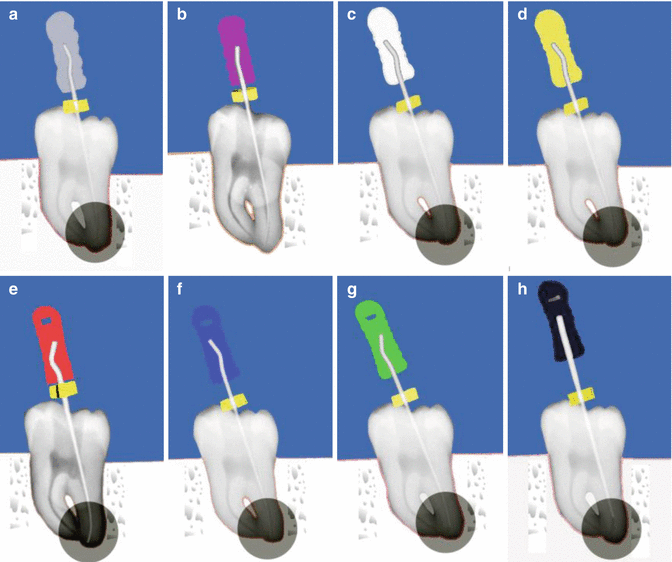
Fig. 3.12
Clinical diagrams representing step-back preparation technique. (a–e) After coronal flaring and determining the master apical file (initial file that binds slightly at the corrected working length), (f–h) the succeeding larger files are shortened by 0.5 or 1.0 m increments from the previous file length. This step-back process creates a flared, tapering preparation while reducing procedural errors. The step-back preparation is superior to standardized serial filing and reaming techniques in debridement and maintaining the canal shape
Step-back technique
- 1.
Working length is determined prior to apical preparation of the canal to a minimum size #25.
- 2.
Stainless steel files should be pre-curved in the apical 2–3 mm and inserted in the same direction as the canal curvature.
- 3.
Recapitulation is recommended using a smaller file to working length with copious irrigation to prevent loss of working length.
- 4.
Patency filing can be used to ensure that apical dentine debris does not block access at the apical constricture. A small #06 or 08K file can be passed 1 mm beyond the apical constricture to ensure patency is maintained.
- 5.
Once apical enlargement has been achieved, serial step-back preparation can be carried out using successively larger files at either 1 or 0.5 mm increments. The latter allows for a greater apical taper if desired.
- 6.
Recapitulation should be carried out with the master apical file (the last file used at the working length prior to step-back preparation).
- 7.
The canal walls can be circumferentially filed using a 25H file to smooth the walls and steps created ensuring a constant taper is achieved.

Stay updated, free dental videos. Join our Telegram channel

VIDEdental - Online dental courses


